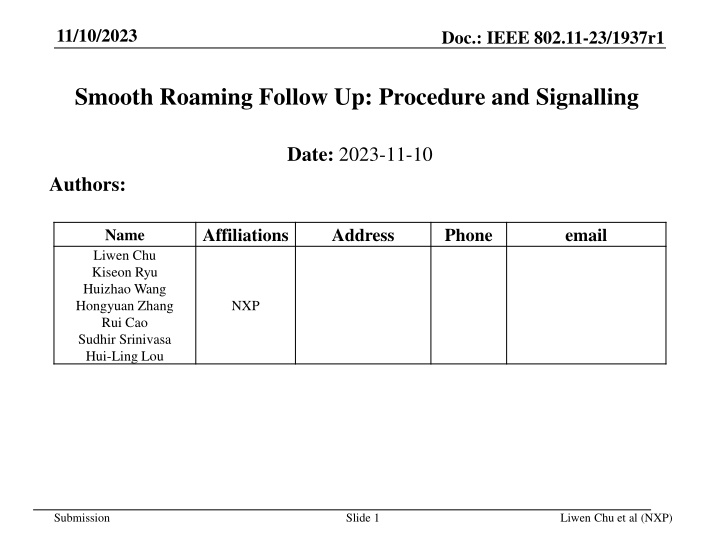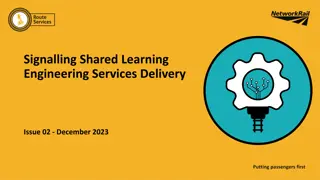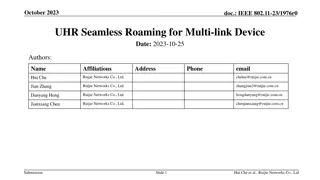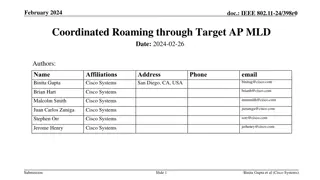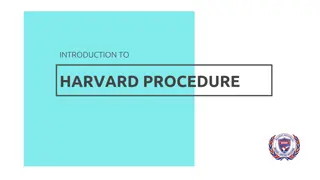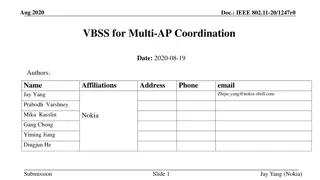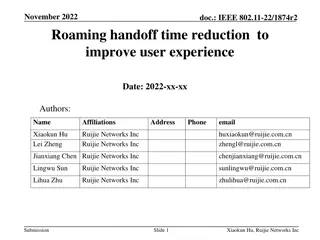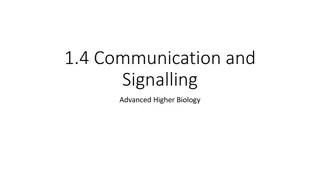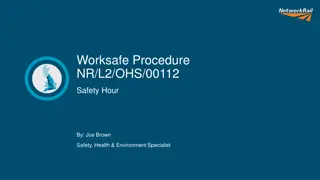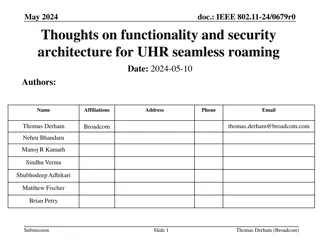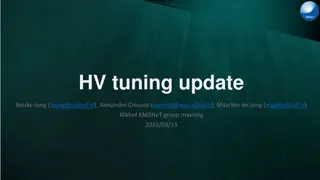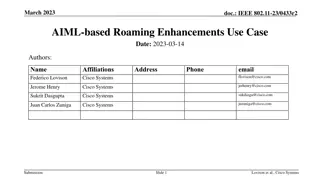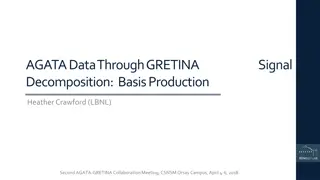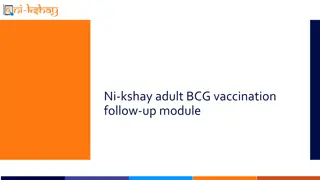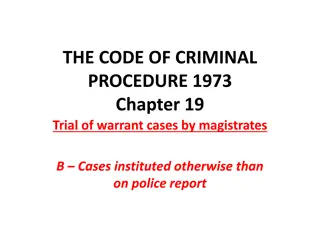Smooth Roaming Follow Up: Procedure and Signalling
IEEE 802.11-23/1937r1 document discusses smooth roaming within a roaming AP MLD, highlighting steps for seamless transition and element updates. Presentation covers roaming AP MLD functionalities, BTM usage, ML reconfiguration, and more.
Download Presentation

Please find below an Image/Link to download the presentation.
The content on the website is provided AS IS for your information and personal use only. It may not be sold, licensed, or shared on other websites without obtaining consent from the author.If you encounter any issues during the download, it is possible that the publisher has removed the file from their server.
You are allowed to download the files provided on this website for personal or commercial use, subject to the condition that they are used lawfully. All files are the property of their respective owners.
The content on the website is provided AS IS for your information and personal use only. It may not be sold, licensed, or shared on other websites without obtaining consent from the author.
E N D
Presentation Transcript
11/10/2023 Doc.: IEEE 802.11-23/1937r1 Smooth Roaming Follow Up: Procedure and Signalling Date: 2023-11-10 Authors: Affiliations Address Phone email Name Liwen Chu Kiseon Ryu Huizhao Wang Hongyuan Zhang Rui Cao Sudhir Srinivasa Hui-Ling Lou NXP Submission Slide 1 Liwen Chu et al (NXP)
11/10/2023 Doc.: IEEE 802.11-23/1937r1 Recap: Smooth Roaming[1],[2] A roaming AP MLD includes multiple distributed AP MLDs. The MLD level functionalities are separated in AP MLD level and roaming AP MLD level. The roaming AP MLD is not visible to non-UHR non-AP MLDs. The roaming within a roaming AP MLD from one affiliated AP MLD of the roaming AP MLD to another affiliated AP MLD of the roaming AP MLD doesn t need the reassociation, key renegotiation. The Link level roaming and MLD level roaming are allowed The multiple serving AP MLD mode through link level roaming is a transient mode and is only used during the roaming procedure for smooth roaming. This presentation discuss the messages and procedure used for the smooth roaming within a roaming AP MLD. Roaming AP MLD2 Roaming AP MLD common MAC Roaming AP MLD2 Roaming AP MLD common MAC Roaming AP MLD2 Roaming AP MLD common MAC AP MLD22 AP MLD22 AP MLD22 AP MLD21 AP MLD21 AP MLD21 MLD common MAC MLD common MAC MLD common MAC MLD common MAC MLD common MAC MLD common MAC 5GHz AP121 6GHz AP122 5GHz AP121 6GHz AP122 5GHz AP121 6GHz AP122 5GHz AP111 6GHz AP112 5GHz AP111 6GHz AP112 5GHz AP111 6GHz AP112 6GHz STA12 5GHz STA11 6GHz STA12 6GHz STA12 5GHz STA11 5GHz STA11 Link level Roaming operation MLD common MAC MLD common MAC MLD common MAC MLD level Roaming operation Non-AP MLD11 with AID 10 Non-AP MLD11 with AID 10 Non-AP MLD11 with AID 10 Submission Slide 2 Liwen Chu et al (NXP)
11/10/2023 Doc.: IEEE 802.11-23/1937r1 Recap: 11be BTM and ML Reconfiguration for ML Setup BTM is used for the associated AP MLD to recommend a new associated AP MLD BTM (BSS Transition Management) Query, BTM Request, BTM Response with the help of update Neighbor Report element. A non-AP MLD can add or delete its setup link through ML reconfiguration Link Reconfiguration Request, Link Reconfiguration Response Submission Slide 3 Liwen Chu et al (NXP)
11/10/2023 Doc.: IEEE 802.11-23/1937r1 Steps for Smooth Roaming Step 1: exchanging the information of the candidate serving AP MLD for the non-AP MLD to select the new serving AP MLD affiliated with the same roaming AP MLD as the current serving AP MLD. This step is optional. Step 2: roaming from the current serving AP MLD to the new serving AP MLD. Through this successful step, the frame exchanges context of the non-AP MLD is established in the new serving AP MLD. Submission Slide 4 Liwen Chu et al (NXP)
11/10/2023 Doc.: IEEE 802.11-23/1937r1 Updated Basic ML Element vs New Type of ML Element Option 1: the roaming AP MLD is announced through updating the Basic ML element. The Roaming AP MLD MAC Address Present subfield and AP MLD Roaming ID Present subfield are added to Presence Bitmap subfield by using any two bits of B7 to B11, e.g. B7 and B8. If the AP MLD MAC Address Present subfield is 1, the Roaming AP MLD MAC Address is carried in Common Info field to indicate the MAC SAP address of roaming AP MLD that the AP MLD indicated by the MLD Address of the Basic Multi-Link element is affiliated with. If the AP MLD Roaming ID Present subfield is 1, the AP MLD Roaming ID field indicates the AP MLD identifier of the AP MLD identified by MLD MAC Address within the Roaming AP MLD. Each AP MLD affiliated with a roaming AP MLD has a unique AP MLD Roaming identifier within the roaming AP MLD. Roam AP MLD level specific features that are not defined by its affiliated AP MLDs may also be in Common Info subfield, e.g. whether link level roaming is supported. The two new Present fields can be combined to one bit. The roaming AP MLD is not visible to a non-UHR non-AP MLD since the non-UHR MLD can t decode the new added (sub)fields. Submission Slide 5 Liwen Chu et al (NXP)
11/10/2023 Doc.: IEEE 802.11-23/1937r1 Updated Basic ML Element vs New Type of ML Element Option 2: the roaming AP MLD is announced through the new type of the ML element. The new type of Multi-Link element is used to announce the roaming AP MLD: Roaming AP MLD MAC Address, AP MLD Roaming ID of the Affiliated AP MLD Roam AP MLD level specific features that are not defined by its affiliated AP MLDs, e.g. whether link level roaming is supported. Submission Slide 6 Liwen Chu et al (NXP)
11/10/2023 Doc.: IEEE 802.11-23/1937r1 Updated Reconfiguration ML Element The Roaming AP MLD MAC Address Present subfield and AP MLD Roaming ID Present subfield are added to Presence Bitmap subfield by using any two bits of B3 to B11, e.g. B3 and B4. If the AP MLD MAC Address Present subfield is 1, the Roaming AP MLD MAC Address is carried in Common Info field to indicate the MAC SAP address of roaming AP MLD that the AP MLD indicated by the MLD Address of the Reconfiguration Multi- Link element is affiliated with. If the AP MLD Roaming ID Present subfield is 1, the AP MLD Roaming ID field indicates the AP MLD identifier of the AP MLD identified by MLD MAC Address within the Roaming AP MLD. Each AP MLD affiliated with a roaming AP MLD has a unique AP MLD Roaming identifier within the roaming AP MLD. The two new Present fields can be combined to one bit. Submission Slide 7 Liwen Chu et al (NXP)
11/10/2023 Doc.: IEEE 802.11-23/1937r1 Neighbor AP MLD Announcement through RNR A new-defined TBTT Information with TBTT Information Field Type that is not 0 is used for the first AP to announce the second AP where the following are true the first AP and the second AP are not affiliated with the same AP MLD. the AP MLD with which the first AP is affiliated and the AP MLD with which the second AP MLD is affiliated are affiliated with the sane roaming AP MLD. The second AP MLD and the first AP MLD are one-hop neighbor (or two-hop neighbor as another example) if the two AP s links supporting the same band work in the same channels. Another variant is that the first AP intends to carry the second AP s information The MLD Parameters field is used to carry the MLD related information of the affiliated AP MLD and affiliated roaming AP MLD. Submission Slide 8 Liwen Chu et al (NXP)
11/10/2023 Doc.: IEEE 802.11-23/1937r1 Information Exchange of Candidate Serving AP MLD BTM Query, Request, Response are used for the information exchange of the candidate serving AP MLD affiliated with the same serving AP MLD as the current serving AP MLD. The Neighbor Report element can carry the Multi-Link subelement for indicating a neighbor AP MLD affiliated with the roaming AP MLD. The Roaming AP MLD can be indicated in the Common Info field of the Basic Multi-Link element. Another variant is that a new type Multi-Link element is defined to indicate the affiliated roaming AP MLD. Submission Slide 9 Liwen Chu et al (NXP)
11/10/2023 Doc.: IEEE 802.11-23/1937r1 Negotiation of Roaming from One Serving AP MLD to Another Serving AP MLD Through Link Reconfiguration Request/Response, a non-AP MLD roams from the current serving AP MLD to the new serving AP MLD, i.e. deleting the links of the current serving AP MLD and adding the links of the new serving AP MLD. The Reconfiguration Multi-Link element in Link Reconfiguration Request indicates the new serving AP MLD and the links being set up. After the reception of the Link Reconfiguration Response where the serving AP MLD switch is accepted, the future serving AP MLD s frame exchange context with the non-AP MLD is ready. The frame exchange context in the current serving AP MLD is cancelled( not be used for frame exchanges any more) for MLD level roaming. Submission Slide 10 Liwen Chu et al (NXP)
11/10/2023 Doc.: IEEE 802.11-23/1937r1 Negotiation of Roaming from One Serving AP MLD to Another Serving AP MLD Links for transmitting Link Reconfiguration Request/Response Option 1: the Link Reconfiguration Request/Response are transmitted through the current serving AP MLD to the roaming AP MLD. Option 2: the Link Reconfiguration Request/Response are transmitted through the future serving AP MLD to the roaming AP MLD. Option 3: the Link Reconfiguration Request is transmitted through the current serving AP MLD to the roaming AP MLD, and the Link Reconfiguration Response is transmitted through the current or the future serving AP MLD to the roaming AP MLD If the AP affiliated with current serving AP MLD is used as the receiver/transmitter of the Link Reconfiguration Request/Response, all the STAs of the non-AP MLD are in power save mode with the future serving AP MLD after the serving AP MLD switch. The Link Reconfiguration Request/Response can do the TWT negotiation, TID-to-Link mapping negotiation, BA agreement negotiation, EPCS enablement etc. with the future serving AP MLD. Submission Slide 11 Liwen Chu et al (NXP)
11/10/2023 Doc.: IEEE 802.11-23/1937r1 Summary We propose: The MLD roaming includes link level roaming and MLD level roaming The multiple serving AP MLD mode through link level roaming is a transient mode and is only used during the roaming procedure for smooth roaming. A non-AP MLD has one serving AP MLD at any time when the roaming is not executed. The new ML element or the update Basic ML element is used to announce the roaming AP MLD. The new ML element is preferable. The updated BTM procedure is used to acquire the neighbor AP MLD s information. The update MLD reconfiguration procedure is used to do the MLD roaming. Submission Slide 12 Liwen Chu et al (NXP)
11/10/2023 Doc.: IEEE 802.11-23/1937r1 Reference [1] https://mentor.ieee.org/802.11/dcn/23/11-23-0170-00-0uhr-smooth-roaming- discussion.pptx [2] https://mentor.ieee.org/802.11/dcn/23/11-23-0632-01-0uhr-smooth-roaming-follow- up.pptx Submission Slide 13 Liwen Chu et al (NXP)
